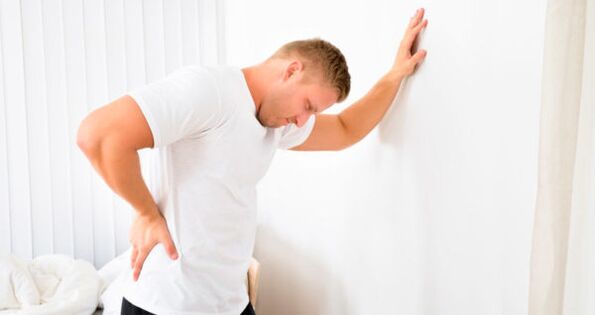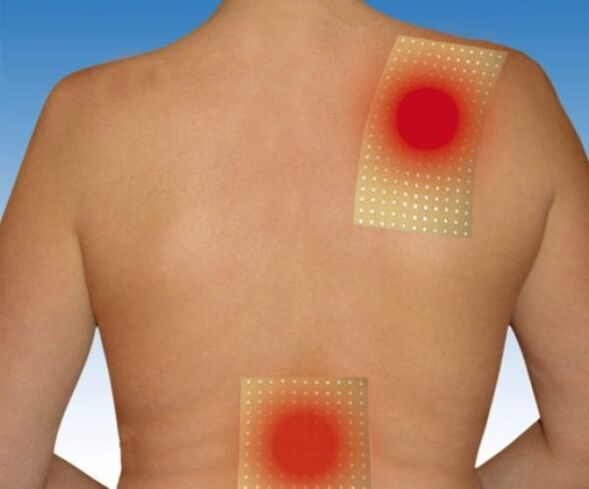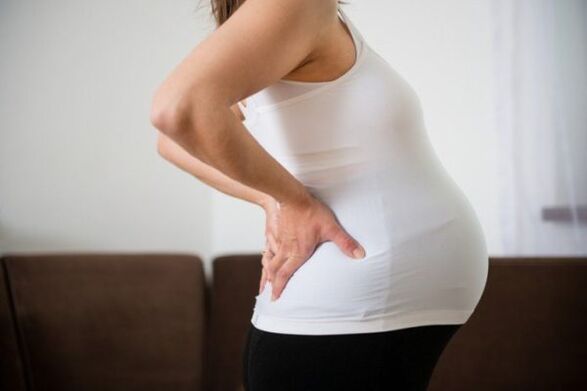For people with back pain, the patch is an easy-to-use, affordable, effective and safe dosage form. It is not able to cure the disease or eliminate the cause of the discomfort because. it is just an important link in the treatment complex. The effect of the patch is to eliminate and alleviate the painful symptoms of the disease, to improve the quality of life at home, without the help of a healthcare professional, without taking pills that damage or damage the gastrointestinal mucosa. injections, which have many side effects and contraindications. Without adversely affecting other systems and organs, the back pain patch delivers the therapeutic agents to the right site, provides sufficient concentration to develop a therapeutic effect, and provides a point effect directly to the source of the pain.

Properties and types of plasters
The patch is a relatively new dosage form associated with the transdermal therapeutic system.
Its distinguishing feature is the unique structure, which has several advantages:
- easy to use, easy to wear - invisibility for others, preservation of freedom of movement, convenience of treatment (depending on the type of product and the expected effect, the patch can be on the skin for 1 hour to 2-3 days);
- the active elements penetrate rapidly into the superficial vessels through the upper layers of the skin, acting purposefully and more rapidly than in forms intended for oral administration;
- systemic effects on the skin are achieved, but the substances are absorbed into the inferior or superior vena cavatheir activity;
- the ability to release the active ingredients slowly on the surface of the dermis, which provides a longer exposure time. This is due to the fact that the body provides a continuous supply of medication at a rate that produces a constant and close to the minimum therapeutic concentration of the medication in the bloodstream;
- absence of withdrawal syndrome with a sharp end to application;
- ability to combine with other drugs, physiotherapies and treatments;
- the release and prolonged effect of the analgesic patch allows the frequency of administration of the prescribed drug to be reduced. This minimizes the systemic and local side effects associated with prolonged repeated administration, the presence and magnitude of a cumulative effect, and avoids any attenuation of the pharmacological effect.

Due to its benefits, transdermal therapy has quickly become popular. Dozens of medical adhesive tapes with different active ingredients are officially registered in the world. It can be divided into groups based on the composition and exposure principle of all existing back pain patches. This division is conditional, as many of them act by several mechanisms and have a complex effect when the effect of one active component is complemented by another effect. Patches from domestic and foreign manufacturers are presented on the pharmaceutical market.
Pharmacies have products from the following brands that specialize in the preparation of dispensed, ready-to-use medicines for external use in the form of patches:
- irritant action;
- with heat-reflecting coating, dry heat;
- non-steroidal or other anti-inflammatory drugs;
- by adding herbs and oils;
- based on chondroprotective substances;
- analgesics with local anesthetics;
- nanotech.
An overview of the most popular back spots
The development and implementation of transdermal therapeutic systems has changed the idea of the patch as a simple injury prevention sticker. The presence of the medication container made the patch an important element in the symptomatic treatment of low back pain and an alternative to parenteral and oral administration. There can be a number of reasons that can cause back pain and difficulty. This can be caused by musculoskeletal problems, diseases of the internal organs, physical overload, hypothermia, pinched nerves, chronic infection, back injury, stress, age-related changes.
In order not to aggravate the situation, the pain can not be ignored, it rarely goes away on its own. Treatment must be timely and competent - an integrated approach is needed. Depending on the type and severity of the pain, the probable causes of it, and the physiological characteristics of the body, your doctor may prescribe one or another medicine.
Only a specialist can, after a survey and thorough examination, determine which medical sticker is better because. differ in principle and tasks. Brief description and characteristics of the most commonly prescribed analgesic patches for the treatment of the back:
- Peppers - the most popular, well-proven. Cheap and efficient. Liquid patch gels are clear, hypoallergenic, and securely attached. The heat build-up when the gel film is applied can be felt after 2 minutes. Capsaicin (hot pepper extract) -based stickers improve blood flow, metabolic processes in the affected area, reduce muscle tension, and are locally irritating, warming, antispasmodic and dissolving. Due to their distraction effect, they relieve pain, while pain is replaced by a mild burning and tingling sensation. Aggressive, may irritate skin. It is indicated for radiculitis, rheumatic diseases, arthralgia syndrome, back neuralgia, lumbago, spinal myalgia.
- A category of thermal plasters that contains a range of materials (turf sand, coke, salt, activated carbon, iron and mineral dust, and the like) that heat up to 40 to 58 degrees in contact with air in just 20 minutes and retain heat. the optimum temperature is 7-12 hours. This subgroup has high costs and relatively long contraindications. Disposable stickers anesthetize, provide even heating, increase blood circulation, and relax the constantly tense deep muscle fibers running through the spine. The warming patch helps with rheumatism, osteochondrosis, lumbar or other back muscle inflammation, chronic arthritis, sciatica.
- The patch weights containing Diclofenac are representative of the class of non-steroidal anti-inflammatory drugs. They work quickly without irritating the skin. They have pronounced anti-inflammatory and analgesic properties. The effect is long lasting. Eliminate the pain associated with the inflammatory process of swelling. The synthetic composition of the non-steroidal structure causes the risk of adverse reactions (the risk increases with prolonged treatment of the patch). Relief is usually given in the acute periods of the disease: inflammation, degenerative spinal changes, lumboischialgia. It is also shown for the back and joints to ensure rapid recovery after overload, injury, sprain.
- Highly targeted adhesive tape containing glucosamine, chondroitin sulfate and neurotropic vitamin B1. The complex of active substances involved in the synthesis of connective tissue enhances the production of cartilage matrix, protects cartilage from damaging factors, helps to restore the hyaline layer, stimulates tissue regeneration. The drug is natural, expensive, provides nutrients and anti-inflammatory substances. Its action is aimed at eliminating the cause of the pain syndrome. This type of patch is recommended for deforming, degenerative-dystrophic lesions of the spine.
- Local anesthetic with lidocaine, a combination of 2 anesthetics. Strong painkillers, provide dermal anesthesia, the effect lasts for 120 minutes after removing the treatment strip from the skin. It can be used for neuropathic back pain, before injections or superficial surgeries.
- Novelties made with special technologies. These include the smallest polymer-based bioactive substances that easily penetrate the layers of the epidermis, reach the sore spot, produce radiation in the infrared region of the spectrum, and create a permanent magnetic field. As a result of the combined effect of the nanoparticles, the local blood flow improves, the lymphatic drainage improves, the pain and inflammatory reactions are relieved, the edema can be removed, the muscles relax and the functions are restored. Patches are indicated for sensitivity violations, neck and lumbar region pain, nerve pinching, sciatica, spondylarthrosis, osteochondrosis, and other pathologies of the spine.
- Herbal stickers - also called Chinese patches. They are not officially registered as medicinal products but as products in the category of hygiene and cosmetic products. Manufacturers emphasize the effectiveness and safety of herbal patches due to the huge amount of useful natural material that forms the basis of the medical disc. There are many variations of adhesive tapes and reviews are mostly positive. Deficiencies include common allergic reactions and a high number of falsifications. The scope is wide, including osteochondrosis of any part of the spine, sciatica.
How to use
All back pain patches are for external use only. They cannot be reused, they must be disposed of after removal from the skin. After removing the protective strip, the product should be applied to a well-cleaned dry skin area in the disturbing area and left to act for the time specified by the manufacturer.
The instruction states that:
- The wine patch can be applied to the skin for 2 days, providing a therapeutic effect. May cause skin irritation and severe burns. Re-application is only possible after a short break. The gel patch is applied in a thin layer to the problem area without rubbing, waiting for it to dry completely. The film formed is removed in one day.
- Heat stains are rarely glued directly to the naked body because the sensed temperature can reach high values, so the manufacturer recommends that they be attached to fairly dense underwear. After opening the sachet and removing the patch, remove the protective foil. Use immediately and completely - do not cut! The maximum duration of use is 10-12 hours per day.
- Patches containing NSAIDs should only be applied for 24 hours, with a maximum daily dose of 30 mg. The duration of treatment should not exceed 21 days.
- Anesthetic patches are placed on the skin in the area of maximum pain. They can be cut, they can be glued to 3 different parts of the body at the same time. Application time - 1-5 hours, then the effect weakens. The interval between repeated treatments is at least 12 hours. The effectiveness of such treatment should be evaluated - if no positive results are seen after 2-4 weeks of regular use, treatment should be stopped.
- Patches with chondroprotectors require prolonged use. Recommended dosing regimen: first week - day and night use (when repositioning, it is advisable to move the patch slightly so as not to unnecessarily obstruct the skin), then during the second week and every other day. The manufacturer's instructions promise that visible changes will occur after 3 months of treatment and that the treatment will need to be continued for at least another 3 months to consolidate the effect.
- Nanotechnological plasters are used in short courses: acute pain - 3-9 days, the stage of chronic disease exacerbation - 9-15 days. You can repeat the treatment after a week break. The duration of continuous application of the adhesive tape to the skin is 12 hours, after which the skin should rest for at least 6 hours. The therapeutic effect is often accompanied by a mild burning sensation and heat redness.

Contraindications to use
When comparing different types of patches, using the safety of treatment as a criterion, quality modern developments are the most advantageous. The list of contraindications for their use is limited to the presence of open wounds, warts, large moles at the site of disc fixation, skin diseases and pregnancy (due to the lack of sufficient clinical data to confirm the safety of fetal development). The next safest patch is Nano Patch GS, which is contraindicated in pregnant and lactating women, children and adolescents aged 0-18 years, and in people with an individual intolerance to the ingredients. The heat patch should also not be used in patients with diabetes mellitus or heart surgery.
The list is closed with NSAID-containing patches with the following contraindications:
- hypersensitivity to non-steroidal anti-inflammatory drugs;
- aspirin triad;
- renal, hepatic dysfunction;
- chronic course of cardiac dysfunction;
- erosion, gastrointestinal ulcers;
- exacerbation of porphyrin disease;
- age of the elderly or children - 0-15 years;
- 3rd trimester of pregnancy or breast-feeding.

Analogs
The above is an exhaustive list of patches on the pharmaceutical market, they have no analogue in this dosage form. The closest effect is other dermal drugs, ointments and gels, sprays that contain the same active ingredient.
Back pain is a reason to see a doctor right away, and self-medication can cause severe pathology in any way.

















































